theartsdesk in Estonia: Tallinn-Narva Music Week review - solidarity through music on the Russian border | reviews, news & interviews
theartsdesk in Estonia: Tallinn-Narva Music Week review - solidarity through music on the Russian border
theartsdesk in Estonia: Tallinn-Narva Music Week review - solidarity through music on the Russian border
Where there is no place for barriers
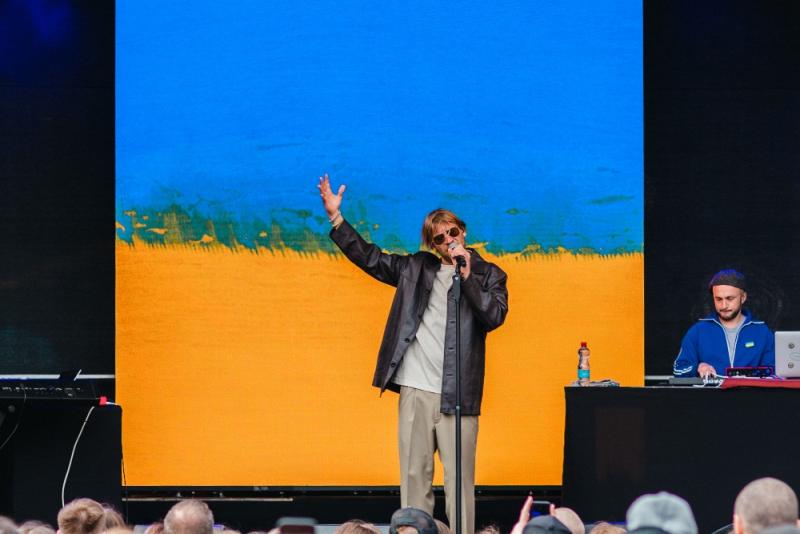
The gentleman in the centre of the picture above is Ivan Dorn. In Ukraine, he’s a pop star. A big pop star. His music, as he puts it on stage during the show opening Tallinn-Narva Music Week, is “pure Ukrainian house music.” Yep, there’s the bing-bong piano lines and cowbell beats of the pop end of house.
Before 24 February this year an Ivan Dorn live appearance would of course be fun, an uplifting experience with a jumping-up-and-down audience doing lots of arm waving. This is confirmed in Tallinn where his enviable charisma is tempered by a charming awkwardness telegraphing he’s not fully polished. He knocks over his water bottle and takes time to wipe up the mess. He stops jogging up and down to tie a shoelace. He drops his microphone. No matter. The beat goes on.
 His country was invaded on 24 February. This outdoor performance is in Estonia’s capital city Tallinn, in the main square of the former industrial district Telliskivi. He says “we have a common value – the freedom of the world” and asks the crowd for donations to help Ukraine. A QR code pops up behind him as do web urls to help the fundraising. He wants “other nations to save Ukraine from prison.” All in, it’s enormously powerful and touching. (pictured right, Ivan Dorn gets moving in Tallinn. Photo by Milla-Esta Koitmaa)
His country was invaded on 24 February. This outdoor performance is in Estonia’s capital city Tallinn, in the main square of the former industrial district Telliskivi. He says “we have a common value – the freedom of the world” and asks the crowd for donations to help Ukraine. A QR code pops up behind him as do web urls to help the fundraising. He wants “other nations to save Ukraine from prison.” All in, it’s enormously powerful and touching. (pictured right, Ivan Dorn gets moving in Tallinn. Photo by Milla-Esta Koitmaa)
Like Ukraine, Estonia shares a border with The Russian Federation. It’s also an independent nation, having extracted itself from the Soviet Union in 1991. Unlike Ukraine, it is in the European Union (from May 2004) and NATO (from March 2004). Its currency is the Euro. It was under Soviet occupation from 1941 to 1991. Before this, it had declared independence from the Russian Empire on 24 February 1918 and was then was briefly under German occupation. But from later in 1918 to 1940 it was independent. Next there were Soviet, German and the final Soviet occupations, after which autonomy came in 1991. Music is central to Estonia and the road to independence was helped by “The Singing Revolution” where expression through song became a formidable tool.
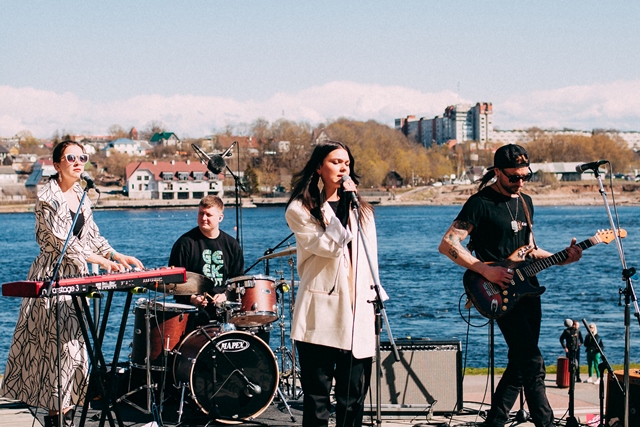 The invasion of Ukraine on the date Estonia celebrates its independence provoked many things. Amongst them was a change of emphasis for the Tallinn Music Week festival. It would now have a twin focus. Tallinn Music Week became Tallinn-Narva Music Week. Narva – a three-hour drive east from Tallinn – is Estonia’s third largest and easternmost city, separated from The Russian Federation by the Narva River. Stand on the Estonia side and look across – there’s Russia. (pictured left, Shira play Narva's riverside – in the background, Russia. Photo by Beata Lamauskaite)
The invasion of Ukraine on the date Estonia celebrates its independence provoked many things. Amongst them was a change of emphasis for the Tallinn Music Week festival. It would now have a twin focus. Tallinn Music Week became Tallinn-Narva Music Week. Narva – a three-hour drive east from Tallinn – is Estonia’s third largest and easternmost city, separated from The Russian Federation by the Narva River. Stand on the Estonia side and look across – there’s Russia. (pictured left, Shira play Narva's riverside – in the background, Russia. Photo by Beata Lamauskaite)
Fast-forward two days from Ivan Dorn. In Narva, in the late-19th century The Resurrection of Christ Cathedral, The Estonian Philharmonic Chamber Choir is singing works by Arvo Pärt under conductor Tõnu Kaljuste. They conclude with Pärt’s “Kanon Pokajanen.” They begin with “Da Pacem Domine.” The opening line is “Give peace, O Lord, in our time.” It is also enormously powerful and touching.
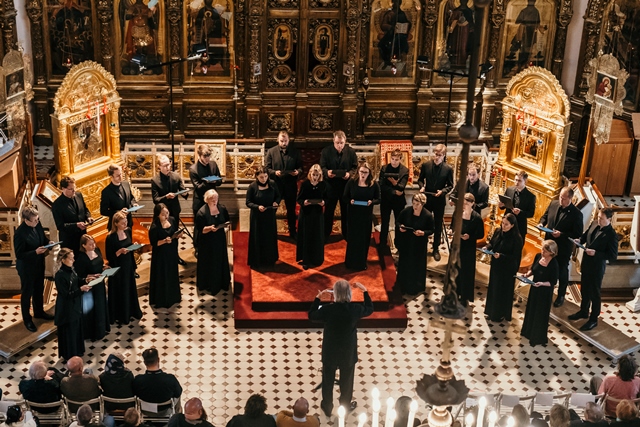 This Orthodox cathedral is in a city where 97% of the population is Russian speaking. Pärt is integral to Estonia and much of the audience for the recital is local. Nothing about this is a day-to-day event: special permission was granted, and allowing it to happen within these walls is an enormous statement of unity; of Estonia being about more than those who have Estonian as their first language. (pictured right, The Estonian Philharmonic Chamber Choir with conductor Tõnu Kaljuste at Narva's Resurrection of Christ Cathedral. Photo by Anna Markova)
This Orthodox cathedral is in a city where 97% of the population is Russian speaking. Pärt is integral to Estonia and much of the audience for the recital is local. Nothing about this is a day-to-day event: special permission was granted, and allowing it to happen within these walls is an enormous statement of unity; of Estonia being about more than those who have Estonian as their first language. (pictured right, The Estonian Philharmonic Chamber Choir with conductor Tõnu Kaljuste at Narva's Resurrection of Christ Cathedral. Photo by Anna Markova)
Outside the cathedral, Narva wears its history. Most of the city’s buildings were constructed during Estonia's pre-1991 Soviet occupation as virtually everything was destroyed late in World War II by a combination of retreating German forces and Soviet bombs. Nonetheless, the medieval Narva Castle (on the Estonian side of the river) and the Ivangorod Fortress face-off against each other on either bank of the river. In view of current times, looking across at Russia from the river’s promenade is unsettling.
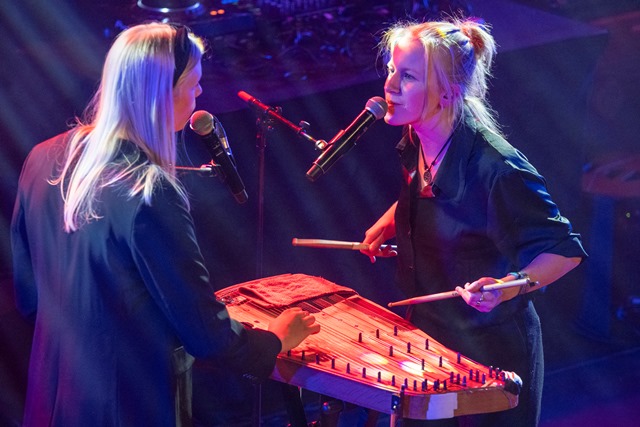 Yet in the midst of this maelstrom of sensations, consciousness of geo-political disturbance, pointless killing, terror and war, Tallinn-Narva Music Week is happening. Given all this, how pedestrian it could be to see live music for the sake of seeing live music. But then again, there’s that penultimate word in Tallinn-Narva Music Week. People are here in solidarity with the understanding that barriers will not be created. (pictured left, Duo Ruut in Tallinn. Photo by Sven Tupits)
Yet in the midst of this maelstrom of sensations, consciousness of geo-political disturbance, pointless killing, terror and war, Tallinn-Narva Music Week is happening. Given all this, how pedestrian it could be to see live music for the sake of seeing live music. But then again, there’s that penultimate word in Tallinn-Narva Music Week. People are here in solidarity with the understanding that barriers will not be created. (pictured left, Duo Ruut in Tallinn. Photo by Sven Tupits)
In Tallinn, Neon Fir are still feeling their way to who they are but the Estonian Sugarcubes about sums up their day-glo, jazz-influenced sensibility. Great. Less direct is what’s billed as Hum of Tartu (Tartu, Estonia’s second city, will be an EU capital of culture in 2024), a collaboration between folk-influenced singer-songwriter Mari Kalkun and Martin Kikas, who plays back sounds recorded out in the environment. If this is the soundtrack to Tartu, then it exists on an otherworldly plane. More straightforward is Irish rapper Chris Kabs, who performs as if he’s in a stadium rather than in a tiny bar, and the Latvian Bert Jansch-style guitarist Edgars Rubenis.
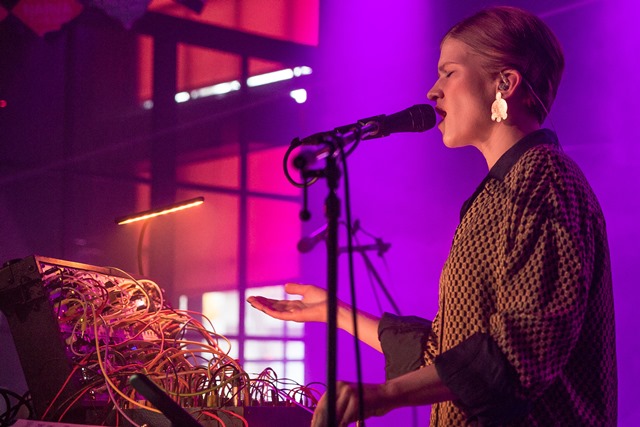 Drawing from local traditions and composing their own material, the Estonian two-piece Duo Ruut share the same kannel (the Estonian zither) and conjure an atmosphere on a line between Nico and Ben Chasny’s drone-folk – they remain melodic though. Amongst their material is a series of spell songs: one to stop bleeding, another to make people dance. There are also folk roots to Maarja Nuut. Her performance consists of live electronics and voice and she has already moved beyond last year’s Hinged album into a space where bells, bird noises and what could be the pulse of the bass pedals of an organ seamlessly fuse with circular vocal lines. It could be impressionistic, but the totality is well-defined and mesmerising. (pictured right, Maarja Nuut in Tallinn. Photo by Kaie Kiil)
Drawing from local traditions and composing their own material, the Estonian two-piece Duo Ruut share the same kannel (the Estonian zither) and conjure an atmosphere on a line between Nico and Ben Chasny’s drone-folk – they remain melodic though. Amongst their material is a series of spell songs: one to stop bleeding, another to make people dance. There are also folk roots to Maarja Nuut. Her performance consists of live electronics and voice and she has already moved beyond last year’s Hinged album into a space where bells, bird noises and what could be the pulse of the bass pedals of an organ seamlessly fuse with circular vocal lines. It could be impressionistic, but the totality is well-defined and mesmerising. (pictured right, Maarja Nuut in Tallinn. Photo by Kaie Kiil)
In Narva, the UK’s Floating Points play an outdoor stage in one of the massive internal courtyards within the still-more massive Kreenholm factory complex. Located on an island in the river, it’s as close as it can get to the landward edge of The Russian Federation. In the 19th century, this cloth-making complex employed up to 7000 people and was one of the largest textile works in the world. It drew power from the adjacent waterfall. The water supplying the falls is sourced in a lake on the Russian side with the flow controlled by a dam. Russia has shut off the dam so the riverbed is mostly dry.
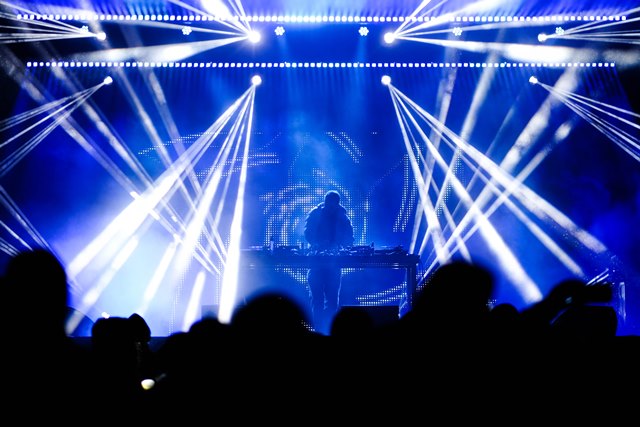 Even so, there is water – lots. It rains as Floating Points play a surprisingly non-exploratory, techno-edged set attracting people to the front of the stage. It could be doubtless be heard meters away in Russia. Before 24 February, when the border was open, locals from across the river could have walked across the nearby footbridge to experience this in person. (pictured left, Floating Points in Narva. Photo by Anastassia Volkova)
Even so, there is water – lots. It rains as Floating Points play a surprisingly non-exploratory, techno-edged set attracting people to the front of the stage. It could be doubtless be heard meters away in Russia. Before 24 February, when the border was open, locals from across the river could have walked across the nearby footbridge to experience this in person. (pictured left, Floating Points in Narva. Photo by Anastassia Volkova)
At NART, Narva’s complex of galleries and performance spaces, Sweden’s Karl Vento is mysteriously intense and hard to place. His voice is keening, and there are suggestions of Neil Young but there are also pop structures. Modulshtein is Estonian and on this occasion is a solo act rather than a band: Squarepusher-infused electronica which would work better in a non-seated venue.
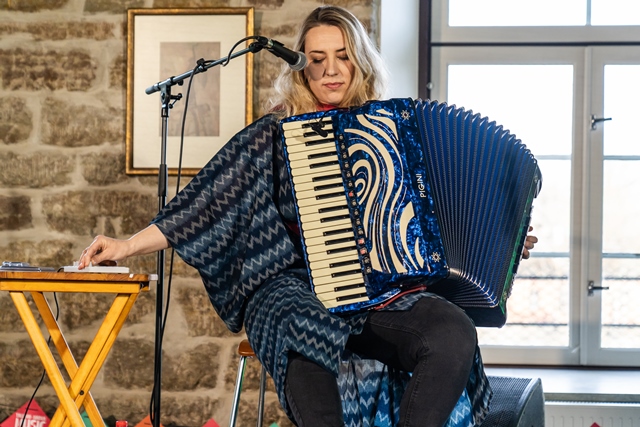 Along an adjacent riverside road at the Narva Gate Office, Tuulikki Bartosik adds texture to her accordion playing by subtly interweaving electronics. One element is not set-off against another: it’s a complete conception. Her set pointedly ended with “Kojusaabumine” (“Coming Home”) from her last album, Tempest in a Teapot. Current-day events were once again inescapable. What was already passionate is suddenly overpowering. (pictured right, Tuulikki Bartosik in Narva. Photo by Anna Markova)
Along an adjacent riverside road at the Narva Gate Office, Tuulikki Bartosik adds texture to her accordion playing by subtly interweaving electronics. One element is not set-off against another: it’s a complete conception. Her set pointedly ended with “Kojusaabumine” (“Coming Home”) from her last album, Tempest in a Teapot. Current-day events were once again inescapable. What was already passionate is suddenly overpowering. (pictured right, Tuulikki Bartosik in Narva. Photo by Anna Markova)
“Coming Home” is about Estonians who fled the serial occupations of World War II: Stalin’s Russia, then Nazi Germany, Russia again. Some escaped to Sweden. From there, 16 men, women and children left in a 37-foot boat for America. On reaching Scotland, sympathetic officials gave them passage through the Caledonian canals to reach Ireland. Then, south to Portugal and west across The Atlantic. They arrived in America 128 days after leaving Sweden. On 18 November 1946, President Truman declared that Estonian political refugees were welcome in America.
This forceful incarnation of history took place alongside the window of a building constructed on the Narva river. Through the glass, Russia. Below, the largely waterless river bed patrolled by two Russian soldiers with a dog. And now, as the story of the Estonian refugees escaping the Russian occupation is retold, recent actions by the country which caused their flight are having the same effect in Ukraine. Does history have to be repeated? Can it not stay buried? Apparently not.
Share this article
The future of Arts Journalism
You can stop theartsdesk.com closing!
We urgently need financing to survive. Our fundraising drive has thus far raised £49,000 but we need to reach £100,000 or we will be forced to close. Please contribute here: https://gofund.me/c3f6033d
And if you can forward this information to anyone who might assist, we’d be grateful.

Subscribe to theartsdesk.com
Thank you for continuing to read our work on theartsdesk.com. For unlimited access to every article in its entirety, including our archive of more than 15,000 pieces, we're asking for £5 per month or £40 per year. We feel it's a very good deal, and hope you do too.
To take a subscription now simply click here.
And if you're looking for that extra gift for a friend or family member, why not treat them to a theartsdesk.com gift subscription?
more New music
 Yazmin Lacey confirms her place in a vital soul movement with 'Teal Dreams'
Intimacy and rich poetry on UK soul star's second LP
Yazmin Lacey confirms her place in a vital soul movement with 'Teal Dreams'
Intimacy and rich poetry on UK soul star's second LP
 Solar Eyes, Hare & Hounds, Birmingham review - local lads lay down some new tunes for a home crowd
Psychedelic indie dance music marinated in swirling dry ice
Solar Eyes, Hare & Hounds, Birmingham review - local lads lay down some new tunes for a home crowd
Psychedelic indie dance music marinated in swirling dry ice
 The Lemonheads' 'Love Chant' is a fine return to form
Evan Dando finally gets back in the saddle with an album of new tunes
The Lemonheads' 'Love Chant' is a fine return to form
Evan Dando finally gets back in the saddle with an album of new tunes
 Music Reissues Weekly: Evie Sands - I Can’t Let Go
Diligent, treasure-packed tribute to one of Sixties’ America’s great vocal stylists
Music Reissues Weekly: Evie Sands - I Can’t Let Go
Diligent, treasure-packed tribute to one of Sixties’ America’s great vocal stylists
 'Deadbeat': Tame Impala's downbeat rave-inspired latest
Fifth album from Australian project grooves but falls flat
'Deadbeat': Tame Impala's downbeat rave-inspired latest
Fifth album from Australian project grooves but falls flat
 Heartbreak and soaring beauty on Chrissie Hynde & Pals' Duets Special
The great Pretender at her most romantic and on the form of her life
Heartbreak and soaring beauty on Chrissie Hynde & Pals' Duets Special
The great Pretender at her most romantic and on the form of her life
 The Last Dinner Party's 'From the Pyre' is as enjoyable as it is over-the-top
Musically sophisticated five-piece ramp up the excesses but remain contagiously pop
The Last Dinner Party's 'From the Pyre' is as enjoyable as it is over-the-top
Musically sophisticated five-piece ramp up the excesses but remain contagiously pop
 Moroccan Gnawa comes to Manhattan with 'Saha Gnawa'
Trance and tradition meet Afrofuturism in Manhattan
Moroccan Gnawa comes to Manhattan with 'Saha Gnawa'
Trance and tradition meet Afrofuturism in Manhattan
 Soulwax’s 'All Systems Are Lying' lays down some tasty yet gritty electro-pop
Belgian dancefloor veterans return to the fray with a dark, pop-orientated sound
Soulwax’s 'All Systems Are Lying' lays down some tasty yet gritty electro-pop
Belgian dancefloor veterans return to the fray with a dark, pop-orientated sound
 Music Reissues Weekly: Marc and the Mambas - Three Black Nights Of Little Black Bites
When Marc Almond took time out from Soft Cell
Music Reissues Weekly: Marc and the Mambas - Three Black Nights Of Little Black Bites
When Marc Almond took time out from Soft Cell
 Album: Mobb Deep - Infinite
A solid tribute to a legendary history
Album: Mobb Deep - Infinite
A solid tribute to a legendary history
 Album: Boz Scaggs - Detour
Smooth and soulful standards from an old pro
Album: Boz Scaggs - Detour
Smooth and soulful standards from an old pro

Add comment